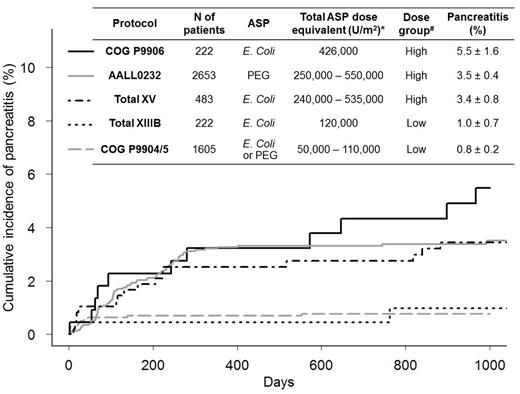Abstract
Acute pancreatitis is a life-threatening complication of acute lymphoblastic leukemia (ALL) treatment. Previous studies have reported that intensive chemotherapy (especially asparaginase) and older age may predispose patients to pancreatitis (Samarasinghe et al. Br J Haematol 2013, Kearney et al. Pediatr Blood Cancer 2009;53:162 and Knoderer et al. Pediatr Blood Cancer 2007;49:634); however only a few large trials and case series have been reported. We studied 5185 ALL patients (age 0 to 30 years) enrolled between 1994 and 2012 on six front-line protocols for childhood ALL (St. Jude Total XIIIB and Total XV; COG P9904/P9905/P9906 and AALL0232) at St. Jude Children’s Research Hospital and in the Children’s Oncology Group. Pancreatitis was diagnosed in 117 (2.3%) patients by clinical symptoms, elevation in the serum amylase or lipase levels and abnormal radiographic or surgical findings according to NCI CTCAE version 2.0 (grade 3-4) or 3.0 (grade 2-4). The first episode of pancreatitis developed during remission induction in 24 of 117 (20.5%) patients and during the first year of therapy (including remission induction) in 104 of 117 (88.9%) patients.
Comparison of asparaginase dose and 3-year cumulative incidence of pancreatitis in different protocols. Native E. coli-asparaginase (E.coli-ASP) and PEG-asparaginase (PEG-ASP) were given intramuscularly at doses shown in the table. *Total dose of native E.coli-ASP (excluding the Extended Induction phase), according to protocol. PEG-ASP administration at 2,500 U/m2 is considered equivalent to native E. coli-ASP at 50,000 U/m2. #Dichotomized by total dose of native E.coli-ASP (or equivalent dose of PEG-ASP) above or below 240,000 U/m2. Abbreviations: ASP, asparaginase.
Comparison of asparaginase dose and 3-year cumulative incidence of pancreatitis in different protocols. Native E. coli-asparaginase (E.coli-ASP) and PEG-asparaginase (PEG-ASP) were given intramuscularly at doses shown in the table. *Total dose of native E.coli-ASP (excluding the Extended Induction phase), according to protocol. PEG-ASP administration at 2,500 U/m2 is considered equivalent to native E. coli-ASP at 50,000 U/m2. #Dichotomized by total dose of native E.coli-ASP (or equivalent dose of PEG-ASP) above or below 240,000 U/m2. Abbreviations: ASP, asparaginase.
Evans:St. Jude: In accordance with institutional policy, St. Jude allocates a portion of the income it receives from licensing inventions and tangible research materials to those researchers responsible for creating this intellectual property., In accordance with institutional policy, St. Jude allocates a portion of the income it receives from licensing inventions and tangible research materials to those researchers responsible for creating this intellectual property. Patents & Royalties, Under this policy, I and/or my spouse have in the past received a portion of the income St. Jude receives from licensing patent rights related to TPMT polymorphisms as clinical diagnostics. Other. Hunger:Jazz Pharmaceuticals: I receive funding for investigator-initiated research of asparaginase from Jazz Pharmaceuticals., I receive funding for investigator-initiated research of asparaginase from Jazz Pharmaceuticals. Other; Sigma-Tau Pharmaceuticals: I receive funding for investigator-initiated research of asparaginase from Sigma-Tau Pharmaceuticals. Other. Relling:Sigma-Tau Pharmaceuticals: I receive funding for investigator-initiated research on the pharmacology of asparaginase from Sigma-Tau Pharmaceuticals., I receive funding for investigator-initiated research on the pharmacology of asparaginase from Sigma-Tau Pharmaceuticals. Other; St. Jude Children’s Research Hospital : I have in the past received a portion of the income St. Jude receives from licensing patent rights related to TPMT polymorphisms as clinical diagnostics., I have in the past received a portion of the income St. Jude receives from licensing patent rights related to TPMT polymorphisms as clinical diagnostics. Patents & Royalties.
Author notes
Asterisk with author names denotes non-ASH members.


